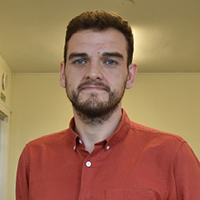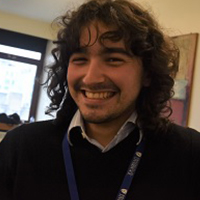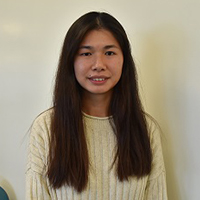Nikhil Reji
 Project title: A virtual assistant for promoting independent recovery and wellness
Project title: A virtual assistant for promoting independent recovery and wellness
Supervisory team: Dr Paolo Paoletti, Dr Kris D’Aout, Dr Ganesh Bavikatte
Ageing is often associate with loss of muscle mass and function, leading to decreased independence and increased risk of injury (e.g. falls). Neurological conditions and physical injuries make this problem even worse. In this project the student will create a platform to allow (semi-)independent rehabilitation and promote active lifestyles in older people. Such a platform will consist of low-cost hardware (RGB and potentially depth cameras) and software that can track the movement of the subject in the camera field of view, check that the activity is done following clinical guidelines and assess the quality of movement.
Sam Hills
 Project title: Helping hand: A soft assistive device for upper-limb rehabilitation and assisted
Project title: Helping hand: A soft assistive device for upper-limb rehabilitation and assisted
Supervisory team: Dr Paolo Paoletti, Dr James Gardiner, Dr Sebastiano Fichera, Dr Ganesh Bavikatte
Ageing is often associated with losses in muscle mass and function, leading to decreased independence and increased risk of injury. The effects of this loss of muscle performance can be partially mitigated by physical activity (e.g. exercise and physiotherapy) and assistive devices. However, the length of therapy provided by NHS is limited due to budget constraints and current assistive devices are often expensive, difficult to design and not user friendly. This project will utilise new advances in soft-robotic technology to design an upper-limb assistive device that overcomes many of the limitations of traditional devices and aids in the rehabilitation and independent living of older people.
Devon Crouch
 Project title: Development of electrospun fibre membranes to support pluripotent stem cell differentiation and delivery of trabecular meshwork cells
Project title: Development of electrospun fibre membranes to support pluripotent stem cell differentiation and delivery of trabecular meshwork cells
PhD supervisors: Dr Lucy Bosworth, Dr Carl Sheridan and Dr Raechelle D'Sa
Positioned in the anterior chamber of the eye, the trabecular meshwork drains aqueous humour through its multi-tiered, highly porous structure into the vascular system. Trabecular meshwork cells are responsible for maintaining the tissue, but ageing and disease reduces its cellularity, resulting in tissue degeneration and blockage of the pores, which leads to fluid build-up and an increase in intra-ocular pressure. This results in glaucoma, the primary cause of irreversible blindness worldwide.
This project aims to develop an electrospun substrate able to support trabecular meshwork cell phenotype and act as a delivery vehicle to repopulate and regenerate the diseased trabecular meshwork.
James Watson
 Project title: Exploring socio-economic and geographic variation in care pathways and their resulting health and economic outcomes for older populations
Project title: Exploring socio-economic and geographic variation in care pathways and their resulting health and economic outcomes for older populations
Supervisors: Dr Fran Darlington-Pollock, Dr Clarissa Giebel, Dr Mark Green, Dr Asan Akpan
Increasing health and social inequalities have resulted in an even greater need for effective targeting and uptake of services. This is emphasised even more amongst our most vulnerable populations, such as older people. An ageing population means a greater number of older people in need of, and potentially accessing, care. This project aims to identify variations in care pathways for older adults, with a particular emphasis on how these pathways vary across different geographic and socioeconomic groups. The primary output will be a predictive algorithm using machine learning techniques, with the aim of predicting the best route through care for individuals; both for optimal, personalised care for the patient and cost-effectiveness for the health and social care system.
Joe Barnes
 Project title: The Design and Development of Bone Assist Devices to Aid and Enhance Bone Tissue Regeneration
Project title: The Design and Development of Bone Assist Devices to Aid and Enhance Bone Tissue Regeneration
Supervisors: Dr Jude Curran, Dr Raechelle D’Sa and Dr James Henstock
Commercial support from Fusion Implant
The prevalence of osteoporosis is increasing with an ageing population and there is a direct clinical need to tackle the issue of poor bone regeneration associated with the disease that directly affects recovery from fragility fractures. These issues are especially relevant in the treatment of fracture sites located at the outer extremities and radius, and poor repair at these sites can lead to enhanced pain, decreased mobility and a reduction in the quality of life. To address this issue, we propose to develop a biodegradable multilayer electrospun membrane for treatments of bone defects via Guided Bone Regeneration (GBR), which will minimize bacterial infection via the production of an antifouling/antimicrobial layer (AL) and support osteogenesis with the incorporation a surface engineered biologically functional layer (FL).
Elliot Croft
Project title: Degradable microneedle arrays for user-directed nanomedicine delivery for the treatment of glaucoma
Supervisors: Dr Helen Cauldbeck and Tom McDonald

This project involves the design and development of drug containing microneedle arrays (MNs) for the treatment of glaucoma; the leading cause of global irreversible blindness, which increases in prevalence with advancing age. Due to MNs sub-micron size they provide a minimally invasive, user directed, sustained drug administration route. MNs will be designed and developed using polymers from FDA approved drug therapies and their chemical and mechanical properties optimised for administration. Comparisons between the efficacy of traditional glaucoma treatments (eye drops) and MNs containing therapeutics will be assessed using radiometric analysis and an ex vivo corneal model.
Naomi Northage
 Project title: Plasma activated liquids for the high-level disinfection of flexible endoscopes
Project title: Plasma activated liquids for the high-level disinfection of flexible endoscopes
Supervisors: Dr James Walsh and Dr Mal Horsburgh
The use of flexible endoscopic devices has become a major feature of modern clinical practice, both for diagnostic applications and surgical interventions. The nature of these devices makes them difficult to clean and disinfect effectively, with over 50% of normally functioning scopes showing evidence of some biofilm formation. This project seeks to develop an innovative new disinfection technology for endoscope reprocessing using non-equilibrium gas plasma. Working with clinical and industrial partners, a plasma device will be developed to eradicate biofilm contamination from within the narrow lumens typical of endoscopic devices.
Gaia Lugano

Project title: Bioengineering a model of the outer blood retinal barrier to test treatments for diabetic retinopathy
Supervisors: Dr Victoria Kearns, Dr Hannah Levis and Dr Tom McDonald
This project aims to engineer a diabetic model of part of the eye and use it to study nanomedicines. Type 2 diabetes is a serious disease and growing problem in the older population. Diabetic eye diseases can lead to sight loss, significantly reducing the quality of life of those affected. Nanomedicines have significant potential to treat diabetic eye diseases. Clinically-relevant models of the diabetic retina will help accelerate the design and translation of new treatments. Gaia will work across the Departments of Eye and Vision Science and Chemistry, developing a wide range of bioengineering and chemistry skills. She will also benefit from clinical supervision and patient interaction, and collaborate with an industrial partner to gain additional technical and commercial skills.
Graeme Pitt
 Project title: Antimicrobial coatings for the prevention of catheter associated infections
Project title: Antimicrobial coatings for the prevention of catheter associated infections
Supervisors: Dr Raechelle D’Sa and Dr Jo Fothergill
Catheter associated urinary tract infections (CA-UTIs) are amongst the most common nosocomial infections and the primary cause of a complication of indwelling urinary catheters. UTIs are the most commonly diagnosed infections in older adults and account for over a third of all nursing home-associated infections. Once an infection occurs, the current treatment regime involves the use of antibiotics which is problematic given the rise multidrug resistance pathogens. The aim of this studentship is to develop novel antimicrobial coatings without the use of antibiotics for prevention and treatment of CA-UTIs.
Sandra Granana Castillo
 Project title: Physiologically Based Pharmacokinetic Modelling for the Optimisation of Complex Clinical Scenario in Elderly Individuals
Project title: Physiologically Based Pharmacokinetic Modelling for the Optimisation of Complex Clinical Scenario in Elderly Individuals
Supervisors: Dr Marco Siccardi and Professor Rachel Bearon
The efficacy and toxicity of drugs can be complicated by a broad variety of factors including patient characteristics such as age and co-morbidities. Older individuals are prone to multi-morbidities, hence polypharmacy and consequently have higher probability of drug–drug interactions (DDIs). DDI can jeopardise the clinical management of therapies and complicate the prescription of treatments. Adverse drug reactions caused by DDIs can represent more than 20% of all reported side effects. The aim of this project is to utilise advanced experimental and mathematical tools for the simulation of clinical scenario, supporting the prediction of DDI and relative risks in elderly patients.
Elfriede Derrer-Merk
 Project title: Risk communication with people in later life
Project title: Risk communication with people in later life
Supervisory team: Professor Kate Bennett, Professor Scott Ferson and Dr Adam Manis
Older people face many challenges throughout their lifetime. People who overcome challenges can be termed resilient. Some of the challenges faced by older people involve uncertainties, for example in health, social circumstance, cognitive status. This project will identify the uncertainties of most concern to older people. The role those uncertainties may, or may not have, on resilience outcomes will be investigated. If uncertainty does impact on resilience, then I will aim to develop a proof of concept for an intervention and or communication tool to manage uncertainty and promote resilience. The findings will be communicated widely to older people, practitioners and policy makers.
Back to: Study